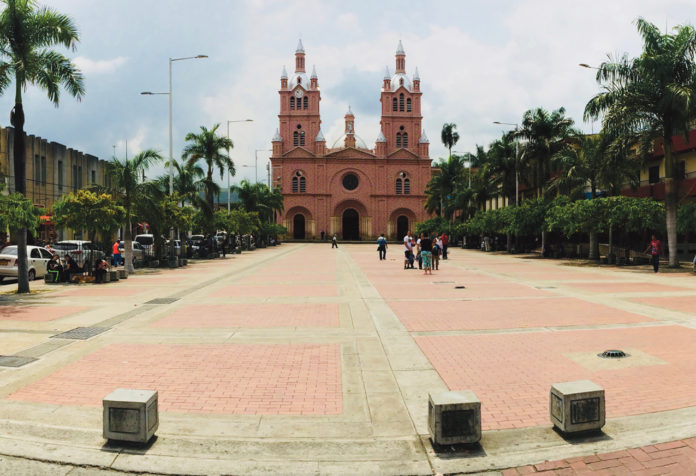One hour north of Cali, the salsa-infused capital of Valle del Cauca, exists Guadalajara de Buga, a quiet town founded in the 16th century. Buga, as Colombians call it, is one of the oldest cities in the country, and a celebrated pilgrimage site for the millions who flock to the Basílica del Señor de los Milagros to pray to a charred crucifix displayed above the central altar.
The diminutive wooden crucifix that was discovered more than five centuries ago in the Guadalajara River by an indigenous woman began to grow into the life-size image of the Christ that today remains a source of amazement and devotion to Catholics. Pilgrims come to Buga from all over Colombia, as seen in the steady stream of tour buses near the Basilica, to pray at the feet of the Messiah believing in his healing powers. After years of deterioration – one bishop even attempted to burn it – the crucifix turned black and began to perspire miracle oil. The “Lord of Miracles” is also known as the “Black Christ of Buga.”
Even though the Basilica is Buga’s main tourist attraction, this picturesque town offers more than religious tourism. Exploring the historic center, visited twice by Liberator Simón Bolívar, you’ll understand why the Ministry of Culture included Buga in its Heritage Towns Network – Red Turística de Pueblos Patrimonio – because in this architecturally diverse town of 70,000 inhabitants are unique, well-preserved buildings dating back to colonial times when Colombia was called New Granada, and more recent Republican structures. The House of Culture, Municipal Theatre and Palace of Justice, as well as 15 churches are just a few landmarks that make Buga a charming place.
For a bird’s eye view of the town, climb the 134 steps of the Monumento El Faro – the only lighthouse in Colombia without a sea – dedicated to Alejandro Cabal Pombo, one of Buga’s most illustrious residents. Alternatively, join sporty locals and walk (or run) up El Derrumbado hill overlooking Buga offering spectacular views of the town below and Western Cordillera.
Take a breather and head to Parque Cabal where old-timers sit on benches under the shade of trees talking to friends, unhurriedly drinking their afternoon tintos. Look out for the huge iguanas, that hide between leafy branches. Replace coffee with some locally brewed beer at the Holy Water Ale Cafe located at the Buga Hostel. Using holy water, the micro-brewery has managed to create some rather intriguing brews: hibiscus, mango and cilantro, and even pumpkin.
Besides architectural gems, Buga also offers several outdoor destinations, which include hikes, cliff diving and waterfalls. Just a short drive out the town, towards a village called Alaska, flows the river where the holy crucifix was reportedly found. An easy hike up from there lies a stunning waterfall called the Cascada de los Milagros. Other natures walks include Los Chorros, where gigantic rocks have created natural swimming pools; perfect for jumping off or soaking up the sun that beats down in the valley. Birdwatchers and nature lovers will be in paradise at the Laguna de Sonso Nature Reserve, a stunning marshland located southwest of Buga. The reserve covers 2,045 hectares and is home to many species of birds, mammals, fish and reptiles. As the area around Buga is yet to be discovered by mainstream tourism, it’s best to go with a guide.
Based on Buga’s huge potential for tourism, the mayor’s office together with the Chamber of Commerce of Buga, Fontur and MINCIT, have launched an ‘experience’ called Buga, Una Espiral del Tiempo – Buga, A Spiral of Time. The tour, available in Spanish and English, takes visitors on a journey through the history of the town, immersing them into a past that is perpetually present in the architecture, culture and stories that have been past on through generations. The tour is enriched by the sudden appearance of actors who portray famous local Buguen?os from past centuries.
Five centuries of stories have been woven together to create present-day Buga: from the time it was founded, through the colonial and Republican eras, up until today. So, whether you’re interested in religious, historical, or environmental tourism, Buga has it all.
Travel Tip: Hotel Guadalajara (Calle 1 Sur No.13-33) and Hostel Buga (Cra. 13 No.4-83) are two options when it comes to accommodation. For trying the local dishes food, check out Maria Mulata Campestre. Costiky offers grilled foods with BBQ ribs their house favorite. Holy Water Ale Café is a divine venue for sandwiches, hummus and of course, enjoying a cold pint.
This article was made possible thanks to the Ministry of Commerce, Industry and Tourism (MINCIT) and Fontur.

